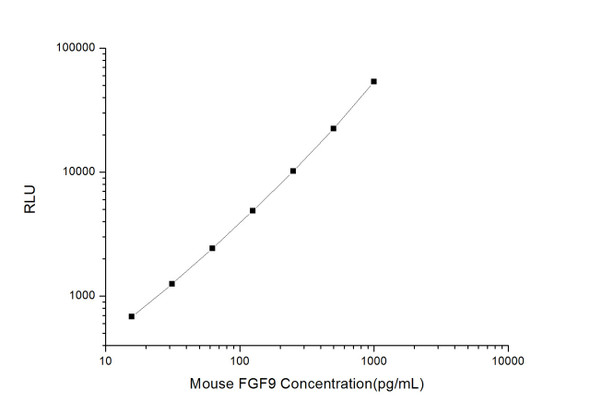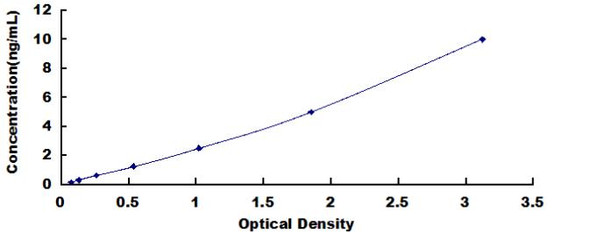Rat Signaling ELISA Kits 2
Rat FGF9 (Fibroblast Growth Factor 9) CLIA Kit (RTES00055)
- SKU:
- RTES00055
- Product Type:
- ELISA Kit
- ELISA Type:
- CLIA Kit
- Size:
- 96 Assays
- Sensitivity:
- 9.38pg/mL
- Range:
- 15.63-1000pg/mL
- ELISA Type:
- Sandwich
- Synonyms:
- FGF-9, GAF, HBFG9, HBFG-9, SYNS3
- Reactivity:
- Rat
- Sample Type:
- Serum, plasma and other biological fluids
- Research Area:
- Developmental Biology
Description
| Assay type: | Sandwich |
| Format: | 96T |
| Assay time: | 4.5h |
| Reactivity: | Rat |
| Detection method: | Chemiluminescence |
| Detection range: | 15.63-1000 pg/mL |
| Sensitivity: | 9.38 pg/mL |
| Sample volume: | 100µL |
| Sample type: | Serum, plasma and other biological fluids |
| Repeatability: | CV < 15% |
| Specificity: | This kit recognizes Rat FGF9 in samples. No significant cross-reactivity or interference between Rat FGF9 and analogues was observed. |
This kit uses Sandwich-CLIA as the method. The micro CLIA plate provided in this kit has been pre-coated with an antibody specific to Rat FGF9. Standards or samples are added to the appropriate micro CLIA plate wells and combined with the specific antibody. Then a biotinylated detection antibody specific for Rat FGF9 and Avidin-Horseradish Peroxidase (HRP) conjugate are added to each micro plate well successively and incubated. Free components are washed away. The substrate solution is added to each well. Only those wells that contain Rat FGF9, biotinylated detection antibody and Avidin-HRP conjugate will appear fluorescence. The Relative light unit (RLU) value is measured spectrophotometrically by the Chemiluminescence immunoassay analyzer. The RLU value is positively associated with the concentration of Rat FGF9. The concentration of Rat FGF9 in the samples can be calculated by comparing the RLU of the samples to the standard curve.
| UniProt Protein Function: | FGF9: Plays an important role in the regulation of embryonic development, cell proliferation, cell differentiation and cell migration. May have a role in glial cell growth and differentiation during development, gliosis during repair and regeneration of brain tissue after damage, differentiation and survival of neuronal cells, and growth stimulation of glial tumors. Defects in FGF9 are the cause of multiple synostoses syndrome type 3 (SYNS3). Multiple synostoses syndrome is an autosomal dominant condition characterized by progressive joint fusions of the fingers, wrists, ankles and cervical spine, characteristic facies and progressive conductive deafness. Belongs to the heparin-binding growth factors family. |
| UniProt Protein Details: | Protein type:Cytokine Cellular Component: extracellular space; cell; cytoplasm; basement membrane; intracellular Molecular Function:heparin binding; growth factor activity; fibroblast growth factor receptor binding Biological Process: negative regulation of Wnt receptor signaling pathway; embryonic skeletal development; negative regulation of transcription from RNA polymerase II promoter; positive regulation of vascular endothelial growth factor receptor signaling pathway; positive regulation of activin receptor signaling pathway; substantia nigra development; positive regulation of MAPKKK cascade; cell-cell signaling; protein import into nucleus; male sex determination; positive regulation of cell proliferation; positive regulation of mesenchymal cell proliferation; chondrocyte differentiation; positive regulation of smoothened signaling pathway; angiogenesis; embryonic gut development; regulation of timing of cell differentiation; positive regulation of cardiac muscle cell proliferation; embryonic limb morphogenesis; inner ear morphogenesis; fibroblast growth factor receptor signaling pathway; male gonad development; osteoblast differentiation; positive regulation of cell division; positive regulation of epithelial cell proliferation; lung development |
| NCBI Summary: | human homolog is a heparin-binding growth factor [RGD, Feb 2006] |
| UniProt Code: | P36364 |
| NCBI GenInfo Identifier: | 25742766 |
| NCBI Gene ID: | 25444 |
| NCBI Accession: | NP_037084. 1 |
| UniProt Related Accession: | P36364 |
| Molecular Weight: | 23. 3 kDa |
| NCBI Full Name: | fibroblast growth factor 9 |
| NCBI Synonym Full Names: | fibroblast growth factor 9 |
| NCBI Official Symbol: | Fgf9 |
| NCBI Protein Information: | fibroblast growth factor 9 |
| UniProt Protein Name: | Fibroblast growth factor 9 |
| UniProt Synonym Protein Names: | Glia-activating factor; GAF; HBGF-9 |
| Protein Family: | Fibroblast growth factor |
| UniProt Gene Name: | Fgf9 |
| UniProt Entry Name: | FGF9_RAT |
As the RLU values of the standard curve may vary according to the conditions of the actual assay performance (e. g. operator, pipetting technique, washing technique or temperature effects), the operator should establish a standard curve for each test. Typical standard curve and data is provided below for reference only.
| Concentration (pg/mL) | RLU | Average | Corrected |
| 1000 | 51982 55368 | 53675 | 53650 |
| 500 | 21213 23765 | 22489 | 22464 |
| 250 | 10319 10103 | 10211 | 10186 |
| 125 | 4493 5309 | 4901 | 4876 |
| 62.5 | 2515 2391 | 2453 | 2428 |
| 31.25 | 1285 1277 | 1281 | 1256 |
| 15.63 | 681 735 | 708 | 683 |
| 0 | 24 26 | 25 | -- |
Precision
Intra-assay Precision (Precision within an assay): 3 samples with low, mid range and high level Rat FGF9 were tested 20 times on one plate, respectively.
Inter-assay Precision (Precision between assays): 3 samples with low, mid range and high level Rat FGF9 were tested on 3 different plates, 20 replicates in each plate.
| Intra-assay Precision | Inter-assay Precision | |||||
| Sample | 1 | 2 | 3 | 1 | 2 | 3 |
| n | 20 | 20 | 20 | 20 | 20 | 20 |
| Mean (pg/mL) | 46.79 | 146.40 | 392.57 | 48.44 | 155.64 | 421.77 |
| Standard deviation | 4.66 | 11.11 | 35.88 | 6.29 | 11.27 | 43.02 |
| C V (%) | 9.96 | 7.59 | 9.14 | 12.99 | 7.24 | 10.20 |
Recovery
The recovery of Rat FGF9 spiked at three different levels in samples throughout the range of the assay was evaluated in various matrices.
| Sample Type | Range (%) | Average Recovery (%) |
| Serum (n=5) | 101-117 | 107 |
| EDTA plasma (n=5) | 91-104 | 98 |
| Cell culture media (n=5) | 98-109 | 103 |
Linearity
Samples were spiked with high concentrations of Rat FGF9 and diluted with Reference Standard & Sample Diluent to produce samples with values within the range of the assay.
| Serum (n=5) | EDTA plasma (n=5) | Cell culture media (n=5) | ||
| 1:2 | Range (%) | 89-102 | 95-108 | 98-115 |
| Average (%) | 95 | 100 | 106 | |
| 1:4 | Range (%) | 99-112 | 87-102 | 98-110 |
| Average (%) | 105 | 93 | 103 | |
| 1:8 | Range (%) | 103-118 | 91-103 | 89-104 |
| Average (%) | 109 | 96 | 95 | |
| 1:16 | Range (%) | 89-101 | 87-100 | 89-103 |
| Average (%) | 96 | 94 | 95 |
An unopened kit can be stored at 4°C for 1 month. If the kit is not used within 1 month, store the items separately according to the following conditions once the kit is received.
| Item | Specifications | Storage |
| Micro CLIA Plate(Dismountable) | 8 wells ×12 strips | -20°C, 6 months |
| Reference Standard | 2 vials | |
| Concentrated Biotinylated Detection Ab (100×) | 1 vial, 120 µL | |
| Concentrated HRP Conjugate (100×) | 1 vial, 120 µL | -20°C(shading light), 6 months |
| Reference Standard & Sample Diluent | 1 vial, 20 mL | 4°C, 6 months |
| Biotinylated Detection Ab Diluent | 1 vial, 14 mL | |
| HRP Conjugate Diluent | 1 vial, 14 mL | |
| Concentrated Wash Buffer (25×) | 1 vial, 30 mL | |
| Substrate Reagent A | 1 vial, 5 mL | 4°C (shading light) |
| Substrate Reagent B | 1 vial, 5 mL | 4°C (shading light) |
| Plate Sealer | 5 pieces | |
| Product Description | 1 copy | |
| Certificate of Analysis | 1 copy |
- Set standard, test sample and control (zero) wells on the pre-coated plate and record theirpositions. It is recommended to measure each standard and sample in duplicate. Note: addall solutions to the bottom of the plate wells while avoiding contact with the well walls. Ensuresolutions do not foam when adding to the wells.
- Aliquot 100µl of standard solutions into the standard wells.
- Add 100µl of Sample / Standard dilution buffer into the control (zero) well.
- Add 100µl of properly diluted sample (serum, plasma, tissue homogenates and otherbiological fluids. ) into test sample wells.
- Cover the plate with the sealer provided in the kit and incubate for 90 min at 37°C.
- Aspirate the liquid from each well, do not wash. Immediately add 100µL of BiotinylatedDetection Ab working solution to each well. Cover the plate with a plate seal and gently mix. Incubate for 1 hour at 37°C.
- Aspirate or decant the solution from the plate and add 350µL of wash buffer to each welland incubate for 1-2 minutes at room temperature. Aspirate the solution from each well andclap the plate on absorbent filter paper to dry. Repeat this process 3 times. Note: a microplatewasher can be used in this step and other wash steps.
- Add 100µL of HRP Conjugate working solution to each well. Cover with a plate seal andincubate for 30 min at 37°C.
- Aspirate or decant the solution from each well. Repeat the wash process for five times asconducted in step 7.
- Add 100µL of Substrate mixture solution to each well. Cover with a new plate seal andincubate for no more than 5 min at 37°C. Protect the plate from light.
- Determine the RLU value of each well immediately.






